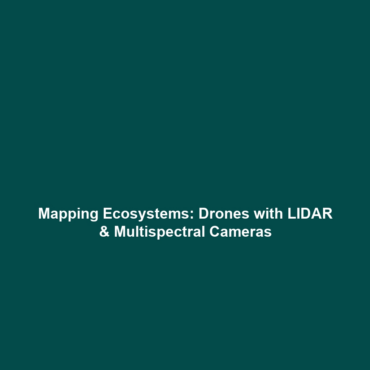“`
Drones with LIDAR and Multispectral Cameras: Revolutionizing Ecosystem Mapping
Introduction
Drones equipped with LIDAR (Light Detection and Ranging) and multispectral cameras have emerged as transformative tools in the field of ecological mapping. These advanced technologies enable scientists to efficiently survey vast areas of forest, wetland, and other ecosystems, providing insightful data that is crucial for environmental monitoring and management. The integration of Drones in Science allows for the collection of rich datasets that improve our understanding of ecosystem dynamics, biodiversity, and land use changes.
Key Concepts
The Science of LIDAR
LIDAR technology utilizes laser light to measure distances and creates precise, three-dimensional information about the Earth’s surface. This data facilitates an accurate assessment of forest structure, topography, and biomass.
Multispectral Imaging
Multispectral cameras capture data at different wavelengths of light. This technology helps in analyzing vegetation health, species composition, and soil properties, which are essential for ecological studies.
Integration of Drones in Science
The use of drones equipped with these technologies aligns perfectly with current scientific needs, bridging the gap between remote sensing and ground-truth research. Such integrations advance monitoring efforts in both conservation and resource management.
Applications and Real-World Uses
The practical applications of drones with LIDAR and multispectral cameras in mapping ecosystems are numerous:
- Forest Inventory: Understanding tree height, canopy cover, and biomass to assess forest health and carbon storage.
- Wetland Monitoring: Tracking changes in hydrology and vegetation to evaluate wetland restoration projects.
- Precision Agriculture: Optimizing crop management through health assessments and yield predictions using drone imagery.
Current Challenges
Despite the numerous benefits, the deployment of drones with LIDAR and multispectral cameras faces several challenges:
- High operational costs and complex regulatory requirements.
- Data processing and storage difficulties due to large data volumes.
- Limited flight time and battery life affecting data acquisition efficiency.
Future Research and Innovations
The future of drones in ecological mapping is promising, with ongoing research focused on:
- Improving battery efficiency to extend flight durations.
- Integrating more advanced sensors for higher resolution data.
- Developing machine learning algorithms to enhance data analysis and interpretation.
Conclusion
Drones equipped with LIDAR and multispectral cameras are at the forefront of a new era in ecosystem mapping. Their ability to provide detailed and timely data is essential for informed decision-making in environmental management. As the technology evolves, its applications in Drones in Science will only expand, leading to better conservation efforts and sustainable practices. To learn more about how aerial technologies impact scientific research, explore our other articles on Drones in Ecology and Remote Sensing Techniques.
“`
This format article comprehensively covers the topic of drones with LIDAR and multispectral cameras, while integrating relevant keywords for optimized search engine visibility.
